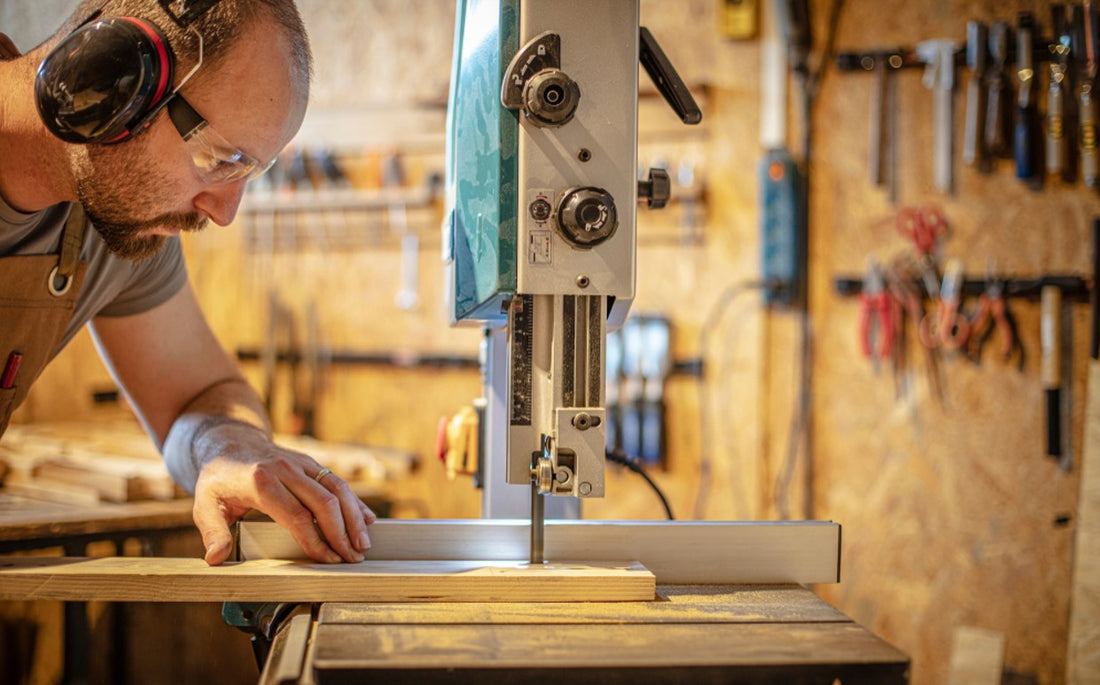When you’re working with bandsaws, you always want to ensure that every piece of equipment you use is properly taken care of. Bandsaws are highly precise instruments that must be in tip-top shape to work properly.
This means you should know the ins and outs of operating tools such as these. In this step-by-step guide, we wanted to go over different types of bandsaws, how blades can differ from one another, and how you can sharpen a bandsaw blade to make your life easier.
While some folks think that sharpening bandsaw blades is a waste of time as new ones are pretty cheap, it’s certainly worth knowing how to sharpen a bandsaw blade, as it can save you a lot of money in the long run.
It’s also a valuable skill if you need to get a rush job done cutting up some lumber or metal and you don’t have the time to get a replacement. We hope that this guide to the sharpening process is helpful to you in your future cutting endeavors.
What Is a Bandsaw?
Bandsaws are cutting tools useful for various DIY projects and professional endeavors. There are multiple types of bandsaws, including vertical, horizontal, and portable. Horizontal bandsaws are generally lauded for their faster cutting ability.
If you have a ton of lumber to cut up, we recommend you go with a horizontal bandsaw for its ability to cut through large amounts of lumber quickly. However, horizontal bandsaws tend to cut through lumber in a much rougher fashion than vertical bandsaws do.
For precision cutting, vertical bandsaws are the way to go. If you’re engaging in fine carpentry or ornate woodworking, a vertical bandsaw is a must-have tool for you and your workshop. Bandsaws are often used in woodworking, but they are often utilized to cut metals and other materials for various purposes.
While bandsaws don’t always do as clean of a job cutting as other kinds of saws, their quick work and user-friendliness make them desirable assets for any DIY worker or professional tradesperson.
Types of Bandsaw Blades
There are three main types of bandsaw blades. If you’re unsure about what kind you’ll be sharpening, you’ll need to understand this. Carbon steel blades are used to cut through all kinds of materials, but they are ideal for metal.
Carbide blades are the blades that you will want to use if you are trying to cut any particularly tough material that you find other blades just can’t get through. Finally, there are bi-metal bandsaw blades, which are the most versatile option by far.
They are ideal for just about any material you come across, generally speaking, but you might find that their overall flexibility makes them a bad pick for when you need to cut a specialized material.

Getting Into the Guide: What You Need to Sharpen Bandsaw Blades
There are a few tools that you can utilize to sharpen your bandsaw blades. If you have the patience, you might want to go with a classic whetstone, but a cut-off disk can also work. You’ll want to have PPE on hand if you use a cut-off disk, so let’s review what you’ll need for that process first.
Cut-off Disk
If you end up using a cut-off disk or cut-off wheel, then you’ll want a good pair of work gloves, long sleeves, and safety glasses. You can use just about any rotary or Dremel tool compatible with your cut-off disk to sharpen your blade but be careful not to go too hard on the blade itself, as this can lead to an overall weaker blade.
It’s also recommended that you go ahead and take the blade out of the saw before you begin the sharpening process. Doing otherwise can also lead to a weaker blade, an inconsistent sharpening session, or some sort of accident occurring, as it’s more tiring to run the saw and hold your Dremel tool in place while sharpening the blade.
We recommend simply taking the bandsaw blade out and rotating it by hand as you smoothly run your rotary tool over each tooth. While this might sound like it’ll take longer, the truth is that once you find a rhythm, this process will lead to the sharpest teeth and the shortest amount of time necessary.
Whetstone
If you decide to use a whetstone to sharpen your bandsaw blade, then more power to you. This is definitely the more time-consuming option, as you’ll need to run each tooth along the side of your whetstone manually. It’ll take quite a bit of hand strength, and we’re willing to bet you’ll start cramping up pretty soon.
After all, a bandsaw is one flexible piece of metal. It can be difficult to hold steady as you use a whetstone. We also wouldn’t recommend trying to sharpen the blade by running the saw over the whetstone, as this might lead to an inconsistently sharpened blade. After all, anyone with experience using a bandsaw likely knows that the resulting cut is sometimes wavy.

Going Over the Process Again
To re-emphasize, we encourage you to invest in quality safety gear before sharpening. You’ll want to be covered from head to toe. You’ll also probably want to skip the whetstone option and use a cut-off wheel, as using a rotary tool will take much less time and likely result in a much more consistently sharpened bandsaw blade. Again, we hope this guide proved helpful, and you’ll continue coming to us for our future articles.

